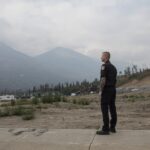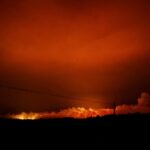In the shadow of last year’s devastating wildfires that forced thousands from their homes, Halifax residents now face a new worry as the city’s cutting-edge wildfire detection system goes dark. The AI-powered surveillance program that monitored Halifax’s urban wilderness for early signs of fire has been discontinued, leaving concerned citizens questioning the municipality’s preparedness for the upcoming fire season.
“It feels like we’re deliberately blinding ourselves to danger,” says Catherine Reynolds, who lost her garage to last year’s Tantallon fire. “After what we went through, cutting this program seems unthinkable.”
The surveillance system, launched as a pilot project in 2023 following the unprecedented wildfires, utilized artificial intelligence to analyze footage from strategically placed cameras throughout the Halifax Regional Municipality’s wilderness areas. The technology could detect smoke plumes and heat signatures long before human observers, potentially providing crucial early warnings that could mean the difference between containment and catastrophe.
Municipal officials cite budgetary constraints as the primary reason for discontinuing the program, explaining that the $1.2 million annual operating cost wasn’t sustainable without provincial support. However, this explanation offers little comfort to residents in vulnerable areas who have grown to rely on the added security the system provided.
Fire prevention expert Dr. James Morrison from Dalhousie University points to concerning statistics that underscore the growing wildfire threat. “Halifax’s urban-wilderness interface has expanded by nearly 15% in the last decade,” Morrison notes. “Simultaneously, we’re experiencing longer, drier summers. This is precisely when we should be enhancing, not reducing, our detection capabilities.”
The Halifax Fire and Emergency Services has assured residents that traditional wildfire monitoring methods remain in place, including regular patrols, watchtower surveillance, and public reporting systems. But critics argue these conventional approaches proved insufficient during last year’s rapidly spreading fires that ultimately consumed over 150 structures.
Municipal Councillor Kevin Thompson acknowledges residents’ concerns but defends the difficult decision. “We’re facing tight budget constraints across all departments,” Thompson explains. “We’re actively seeking provincial funding to reinstate the program before peak fire season arrives in July.”
The provincial government, meanwhile, has remained noncommittal. In a statement to CO24 News, a spokesperson for Nova Scotia’s Department of Natural Resources indicated that wildfire prevention funding is “under review” as part of broader emergency preparedness initiatives.
For residents like Michael Donovan, whose Hammonds Plains neighborhood was evacuated twice last summer, the shutdown represents a troubling step backward. “Technology finally gave us a fighting chance against these fires,” Donovan says. “Now we’re back to relying on someone spotting smoke on the horizon and hoping it’s not too late.”
Environmental analysts point out that Halifax’s situation reflects a broader Canadian challenge of maintaining innovative prevention programs against increasing climate-related threats while navigating fiscal constraints. Similar AI-powered detection systems have proven highly effective in British Columbia and parts of California, where early detection has demonstrably reduced wildfire damage.
As Halifax approaches another potentially dangerous fire season, the question remains whether traditional methods will suffice or if the absence of this technological safeguard will leave the community vulnerable once again. With memories of evacuation orders and smoke-filled skies still fresh, residents are left wondering: at what point does cutting costs create unacceptable risks for a community still healing from disaster?

























